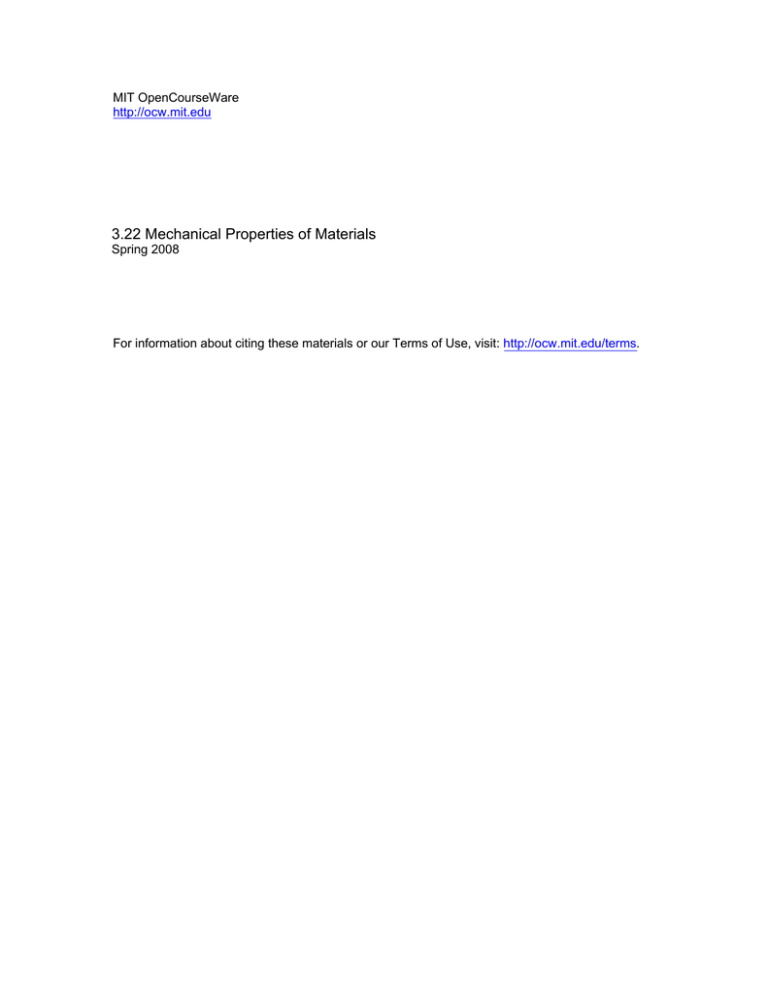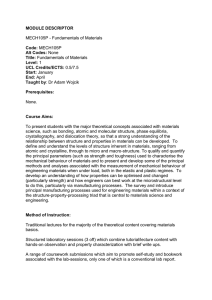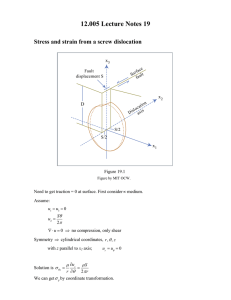3.22 Mechanical Properties of Materials
advertisement

MIT OpenCourseWare http://ocw.mit.edu 3.22 Mechanical Properties of Materials Spring 2008 For information about citing these materials or our Terms of Use, visit: http://ocw.mit.edu/terms. 3.22 Mechanical Behavior of Materials Spring 2008 Quiz 3 • • • • • Show all your work on the sheets included in this stapled document. Use partial credit to your advantage. If you're running short on time, solve algebraically and then solve numerically (plugging in numbers) later. If there is not much space given for you to provide an answer, I want you to be brief. You may not need to use all the information given (e.g., dimensions) to reach your conclusions. Enjoy your fruit/nut mixture before getting started! Nuts and dried fruits reduce low-density lipoprotein cholesterol, decrease oxidative damage to tissues, and improve indices of cardiovascular disease associated with stress. NAME (PRINTED): I agree that this document represents my own independent work on this quiz, using only my own brain, my allowed crib sheet of equations and notes, and my pen / pencil / calculator / protractor / compass / ruler / sliderule. SIGNATURE: 1. Material stiffness and strength are very different properties attributed to very different atomistic mechanisms. In <60 words, clearly and accurately state the difference between these two concepts in a way that should be perfectly clear to any engineer, physicist, or chemist. 2 2. We have discussed that dislocations can be challenging to view via TEM because they tend to “anneal out”, or glide to the free surface of a thin foil (circle of D ~ 3 mm, punched from a 100 μm-thick sheet of the material). This can be understood with use of image forces, imaginary dislocations outside the material that exert a stress Σ according to the self-stress of a dislocation that is of opposite Burgers vector (but same slip plane) to the one inside the material. It is “upside down” outside the crystal, so it looks like an inverted mirror image: 3 mm free surface 100 μm TEM foil δ (a) In the above diagram, two dislocations (one real and one imaginary) are shown with a common slip plane. Determine the forces (in terms of all appropriate variables) on the real dislocation due to its image force dislocation. To determine the position of the image force, consider the magnitude of stresses at a free surface. (b) Due only to the Σ imposed by the image force dislocation, under what conditions will this dislocation inside the crystal glide, and under what conditions will this dislocation climb? As a result, do you expect this dislocation to maintain a stationary location within the crystal? (c) Why is the real dislocation “attracted” toward the surface? It may help to think of this as a composite problem. (The answer is NOT that there is an opposite dislocation nearby, because this is an imaginary dislocation that reflects the physics of the attractive forces.) (d) A foil has been prepared at room temperature, with a dislocation located a distance δ from the free surface of the foil. Draw what you expect the dislocation to look like when in a TEM foil in plan view, and in cross-section. 3 3. (a) For the following material, compare the magnitudes of increased strengthening (Δτ ~ Δσy) for the major strengthening mechanisms we’ve discussed. Estimate any required structural and mechanical properties of the phases of this material, based on your knowledge of similar materials. REFERENCE MATERIAL: 100% Cu of grain size d = 10 μm and dislocation density 109/cm2. ALTERED MATERIAL: 75 vol%Cu / 25 vol%Ni of grain size d = 5 μm, containing 5 vol% Cu2O3 particles of radius r = 0.1 μm and particle/matrix surface tension of 0.1 J/m2, as well as a dislocation density of 1011/cm2. (b) The main application of this material is for US coins. How would you further modify the above structural and mechanical properties of the ALTERED MATERIAL to reduce the energy consumption required to stamp the coins? 4 4. A thin sheet of amorphous polymer, shown below, has been deformed and halted prior to fracture. Using your knowledge of yield surfaces and energy dissipation mechanisms in such materials, clearly state the stress tensor components (relative value and sign, referenced to your choice of coordinate axes) that must have been imposed to result in such a final appearance that is visible to the eye. ? ? ? ENJOY YOUR WEEKEND FULL OF SUNSHINE! 5





